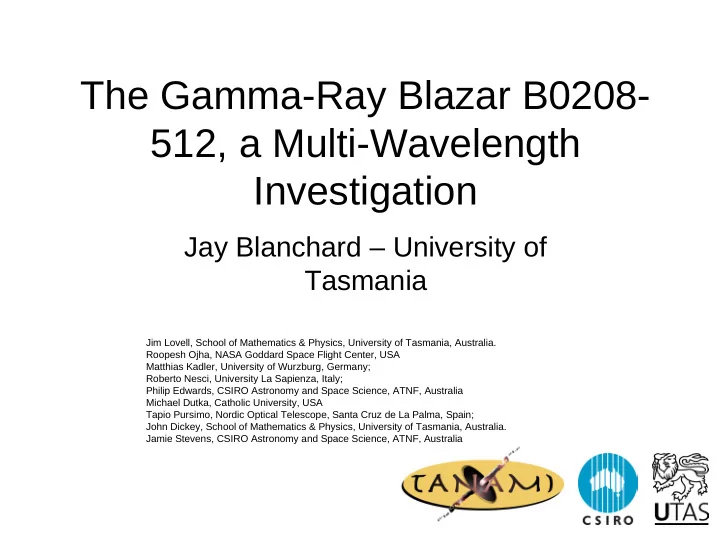

The Gamma-Ray Blazar B0208- 512, a Multi-Wavelength Investigation Jay Blanchard – University of Tasmania Jim Lovell, School of Mathematics & Physics, University of Tasmania, Australia. Roopesh Ojha, NASA Goddard Space Flight Center, USA Matthias Kadler, University of Wurzburg, Germany; Roberto Nesci, University La Sapienza, Italy; Philip Edwards, CSIRO Astronomy and Space Science, ATNF, Australia Michael Dutka, Catholic University, USA Tapio Pursimo, Nordic Optical Telescope, Santa Cruz de La Palma, Spain; John Dickey, School of Mathematics & Physics, University of Tasmania, Australia. Jamie Stevens, CSIRO Astronomy and Space Science, ATNF, Australia
Outline • The TANAMI project • Introduction • PKS 0208-512 • The Data • Discrete Correlation Function • Lag vs Frequency analysis • VLBI data • Future work.
TANAMI • TANAMI - Tracking Active Galactic Nuclei with Austral Milliarcsecond Interferometry. • Tracks the jets of sources south of -30 degrees declination using the Australian Long Baseline Array (LBA). • Observes at 8.4 and 22 GHz at a cadence of about 2 months.
TANAMI
TANAMI - ATCA • TANAMI has several facilities that are supporting the VLBI observations. • This includes the Australia Telescope Compact Array (ATCA). • ATCA consists of six 22m dishes. • The ATCA observes the TANAMI sources at frequencies between 1.3 and 44 GHz for a 12 hour block every 6 weeks. • See poster by Jamie Stevens!
TANAMI - ATCA Credit: Emil Lenc -CSIRO Astronomy and Space Science, ATNF, Australia
TANAMI - Ceduna • Ceduna is a 30m ex-Telstra communications dish outside Ceduna in South Australia. • This has been repurposed by the University of Tasmania for astronomical observations. • Can observe at frequencies between 2.4 and 22 GHz. • Observes ~40 AGN at a cadence of 2 weeks at 6.7 GHz, as well as 12 sources at a daily cadence.
TANAMI - Ceduna
Introduction • The emission mechanism of the gamma-rays observed from blazars is as yet poorly understood. • The mechanism itself is possibly inverse Compton upscattering (see for example Acciari et al. 2010). • The emission site (and hence the origin of the seed photons) is still uncertain.
Introduction • Gamma-ray emission likely occurs after the formation of a shocked region in the jet (Lahteenmaki and Valtaoja 2003). • So the delay between the radio and gamma ray emission generated by the event can be used to identify the location of the emission site. • In the era of the Energetic Gamma Ray Experiment Telescope (EGRET), early work in the field suggested that the gamma-ray flares are preceded by high frequency radio flares (Valtaoja and Terasranta 1995).
Introduction • More recent work, suggests the gamma-ray emission is leading the radio (Kovalev et al. 2009, Pushkarev et al 2010). But is mixed, with some showing the opposite lag. • The expected lag using these calculations is approximately 1.2 months in the source frame, and depends on frequency. • They suggests the emission is coming from the core of the blazar, and that the delay is due to optical depth affects.
PKS 0208-512 • B0208-512 is a blazar with a redshift of 0.999. • Shows a one sided jet at radio frequencies extending to approximately 20 mas (Tingay et al 1996). • Strong and variable X-ray source, first detected by the Röntgen Satellite (ROSAT) (Voges et al. 1999). • The first gamma-ray detection of the source was by EGRET (Bertsch et al. 1993). • B0208-512 has shown flaring events in all frequencies.
The Data • We have multi-wavelength data going back several years including: – Radio data between 1.3 and 96 GHz using the ATCA. – Radio data at 6.7 GHz from Ceduna. – Optical data from REM. – X-ray data from SWIFT-XRT. – Gamma-ray data from Fermi
DCF • Discrete correlation function calculated for all radio data pairs as per Edelson and Krolik (1988). • Fitted with Gaussian using least mean squared. • Covariance matrix gives error in the fit. • Example gives a lag of -47 days +- 16.
Lag vs Δ Frequency
VLBI
VLBI
Current and Future Work • Currently working on significance of DCF. • Cross correlation between radio and x- ray/gamma-ray. • More VLBI epochs – modelling of components. • Reduction of SWIFT-XRT UV data. • Flaring and Quiescent SED.
Recommend
More recommend